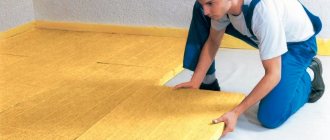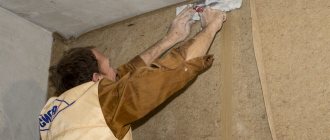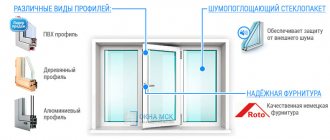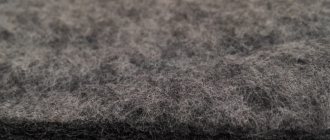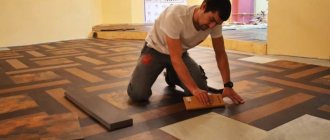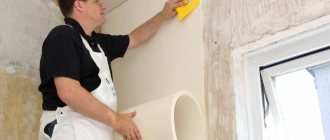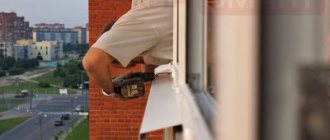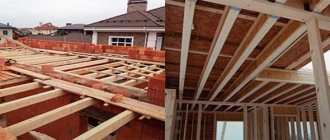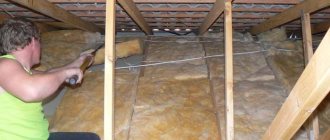Modern multi-storey buildings do not have good sound insulation. Many residents carry out isolation measures on their own. Fortunately, today the building materials market allows you to select materials that meet the parameters and characteristics of the buyer. Depending on the intended work, you can select the appropriate sound insulation in a panel house.
@Panel'nii dom
Reasons for poor sound insulation of panel houses
The main reason for poor sound insulation of panel houses is non-compliance with construction technology. Many developers, in order to save money, do not include soundproofing measures in the construction plan, which is why the residents of these buildings suffer.
Panel houses consist of reinforced concrete structures, which, despite their small thickness, perfectly conduct various sounds. If, for example, someone is renovating a house, then even on the top floor you can hear it as if work is being done behind your wall.
@Panel'nii dom
Also, do not forget that each panel block is manufactured quickly enough, and few people worry about cracks and cracks, but it is through them that many different sounds pass. Solving the problem with developers is problematic, since everything in the documentation presented is as it should be, but in reality it is very difficult to determine whether there is sound insulation or not. Everything will be revealed after you move into the apartment...
In order to ensure the most comfortable conditions in your apartment, it is necessary to deal with sound insulation even at the stage of rough renovation, especially since the variety of building materials allows you to choose exactly what you need.
Soundproofing methods
To determine soundproofing methods, you should first understand what sounds disturb a panel house and what you need to protect against. There are two main types of noise that are found in panel houses: impact and airborne. Speaking of airborne noise, it is transmitted through the air.
As a rule, these include a loud TV, a quarrel between neighbors behind the wall, or the operation of household appliances. As for the shock, its origin depends on whether the house is being renovated or not. It is transmitted over hard surfaces of the structure, and getting rid of it is much more difficult than airborne.
There are currently three main soundproofing methods recognized:
- Frame;
- Frameless;
- Floating.
The frame installation method is the installation of a frame base made of wooden beams or an aluminum profile. According to the technology, plates that absorb sound waves are placed between the guides of the structure. Afterwards, sound-reflecting materials are installed, which provide maximum protection from various noises and sounds. In some cases, the outer layer is not a reflective, but an absorbing surface.
@Panel'nii dom
As a rule, this finishing option is used for recording studios and similar premises. The main advantage of this method of sound insulation is its effectiveness. It is possible to reduce the noise level in the apartment as much as possible, while the cost of such insulation will be relatively low and quite affordable. The only downside is the loss of space in the room. If similar work is done on each wall, floor and ceilings, then the overall square footage may suffer by several square meters.
The frameless method of sound insulation involves the use of special slabs, panels and membranes of small thickness. In this soundproofing technology, the material is attached or glued directly to the surface of the wall and ceiling. The final stage of work is the use of finishing or thin cladding panels. If you carry out soundproofing measures correctly, you can create optimal conditions with minimal loss of space. In addition, without using a frame base, you can save on materials.
You can read more about this soundproofing method in this Article.
@Panel'nii dom
The floating method is suitable exclusively for flooring. The essence of insulation is that soundproofing material is laid on the subfloor, and a screed is made on top of it. Due to the fact that the floor base does not come into contact with the walls, a good soundproofing effect is obtained. Using this technology, you can not only get a floor through which no sound passes, but also achieve complete sound insulation by combining various technologies.
@Panel'nii dom
Of course, you can protect one wall through which sounds are constantly heard, but such work will not be considered effective, because only with combined insulation can the necessary results be achieved.
Club of Defenders of Silence
Ever since I encountered the problem of poor sound insulation in a panel house (137 series), I have become very interested in the topic of audibility in apartment buildings, especially in standard buildings. I was surprised, is this really how all people live, is it really possible that you can hear stomping and voices everywhere? I spent almost a year moving. And for the search, all available information on the Internet was searched, thousands of conflicting reviews about different types of houses were read. You know, it is very difficult to get rid of the illusion that there are “high-quality brick houses with good sound insulation” and there are “terrible panel houses with high audibility.” These cliches were so ingrained in my brain that it seemed to me that if I moved into a brick house on the middle floor, it would be better than the last floor in a panel house. And I admit that if I could quickly sell my old apartment, I would move to a brick house on the middle floor. This was the biggest mistake, because the stomping of neighbors from above does not depend on the type of house, but on the flooring, which neighbors can install in any way (laminate, linoleum), and also in many houses that I looked at in apartments, one of the walls of the rooms was not made of brick, and from double slabs of plaster. But then I had illusions and didn’t know about it, I wanted to leave the panel hell for any house, as long as it wasn’t a panel.
First of all, I want to note that when we talk about soundproofing an apartment, we are not talking about the fact that the apartment can be as quiet as a crypt. In any case, it will be quieter in a private house without neighbors. The apartment will be a compromise in any case. Previously, I read with skepticism recommendations that if you want silence, go to a private house. And when I began to study the soundproofing capabilities of standard building materials, it became clear to me that the apartment would be quiet as long as the neighbors were normal. No house can protect you from violent neighbors. Moreover, violence can manifest itself in many aspects. Neighbors don’t have to be antisocial, drink, rowdy, throw parties, sing karaoke to make life miserable. Some set up almost mini-productions at home for the manufacture of chairs and other nonsense, annoying for years (although these cases are rare). Some neighbors may practically not leave the house (being, for example, a housewife) and run around all evening, driving their heels into the floor like hooves. Nothing illegal, but you won’t be able to live in comfort. The neighbors may have a small dog that will bark all day long, and there will be no way to save it. Or maybe a hyperactive child, always running around and dropping everything. It is impossible to get rid of all noise for adequate money, so any apartment is a big risk. The risk is so great that I personally am even scared of the prospect that in the future I will have to move somewhere again or that the neighbors will change, and I want to light a candle in the local church for the adequacy of my neighbors and my health. But at the same time, I do not agree with the statement that sound insulation depends only on the neighbors, that all apartments are the same, etc. In my old apartment, the neighbors were adequate, but there was no life in it. So how do you find an apartment with good soundproofing? What to look for?
1. The main rule is to choose the correct location of the apartment: Only the top floor. For our forum, the advantages of the last floor are obvious. But if you read the Internet, you can find so many terrible stories about the top floor that it becomes embarrassing: - The elevator will break down, it’s like walking (or the lights will be turned off) - The roof will leak - The sun will heat the apartment like hell, much more than on the middle floor — Elevators and other engineering equipment will interfere with you. — Pigeons, etc.
In my opinion, the following fears can be fully justified: - If there is no technical floor, then there may be pipes on the ceiling in the corridor, which somewhat spoils the aesthetics. But I haven’t seen such a problem in houses with a technical floor. — Elevator noises. This problem is possible, I came across it a couple of times on the Internet, that supposedly the operation of the elevator motor can be heard throughout the apartment. But, in my opinion, this is a big exception to the rule. Most likely, the installation (or location) rules for the motor have been violated. If everything is done correctly, you won't hear the elevator at all. — It’s hotter on the top floor on the sunny side. If there is a technical floor, then of course the roof has no effect and the hot roof is unlikely to heat the apartment on the top floor. Rather, the factor here is that in many apartments on the top floor the sun is not blocked by anything, so it can burn from morning to evening. Not only the residents of the top floor, but also many apartments, even starting from the fifth floor, suffer from such sun. It’s easy to judge this, you can just look at the facade of a house facing West and see how many blinds, reflective films and blackout curtains are located on the balconies and loggias. Most of the heating comes from the sun shining through the window, rather than from heating the walls or ceiling.
You and I, of course, know the main advantage of the last floor: no one stomps on your head. Unfortunately, this does not eliminate the presence of neighbors on the side or below. The stomping of neighbors below or to the side can also be heard, although quieter than above (2-3 times). However, like loud music or TV, they penetrate the walls like a knife. Therefore, it is very important to minimize the number of neighbors; it is better to border on the elevator hall or staircase than on neighbors. It is advisable to look for an apartment with 1 border with neighbors.
2. Type of house. The most common types of houses: - brick - monolithic - frame-monolithic - panel - block.
BRICK HOUSES. This type of house is valued more in terms of sound insulation than other types of houses. It is believed that brick is an ideal sound insulator. When I first started looking for an apartment to move to, I only considered brick houses. The legend of 100% soundproofing of brick houses has lived in us since childhood. If you briefly read the information from the Internet, you can find a hundred articles, identical in content, where they clearly put brick houses in first place, without mentioning any of the nuances that can negatively affect the sound insulation of an apartment in a brick house. Let's try to understand the pitfalls in brick houses. First of all, you need to understand that brick houses are completely DIFFERENT. Let's make a conditional division of houses by year of construction: - Old building before 1917 - Stalinka - Brick Khrushchev - Brick Brezhnev - Brick houses of the 90s-early 00s - Brick houses since 2000.
What is each type of house? — Old foundation before 1917 These houses are the most unpredictable in terms of quality and sound insulation. You need to study the house plan and technical documentation of the house in detail. Many houses have wooden floors (good vertical audibility). Often the walls with neighbors are made of thin partitions (shingles). Therefore, in addition to expensive repairs, you can get excellent audibility. - Stalinists. Many types of Stalin buildings are more expensive than modern economy or comfort class houses. This is due to their advantageous, for the most part, location, high ceilings and prestige. Disadvantages: lack of an elevator, or the presence of one small passenger elevator. Communications may not be designed for the power of modern electrical appliances. The ceilings in many Stalinka buildings are wooden. The variety of layouts has led to the fact that in Stalin buildings there are also many apartments where the wall between the apartments is made of shingles or half a brick, which is why you can hear the neighbors on the side very loudly. — Brick Khrushchev buildings Even in this standard series there are many modifications: for some, all the walls are made of brick, as I had in the 1-528KP series (including the bathroom and interior partitions), and for others, even the wall with the neighbors is made of a double wall made of plaster panels through which everything can be heard. You need to study the apartment plan and tap all the walls to make sure that the walls between neighbors are solid. — Brick Brezhnevka. Initially, the apartment layouts were very monotonous. The apartments were divided into rectangular sections; as a rule, the walls were all thick. But at the same time, the apartments were one-sided, i.e. All the windows in the three-room apartment faced either the courtyard or the street. It wasn't very convenient. And it was decided that all apartments should have at least one window facing the street or avenue, i.e. to the front of the house. As a result, as now, one-room apartments usually have all 2 windows facing the street, two-room apartments and three-room apartments have two-sided apartments (i.e., facing the courtyard and onto the street). Two-room and three-room Brezhnevka apartments are rarely one-sided anymore; apartments with a “open-wing” layout are appearing. The layout is becoming very popular when one of the rooms faces the opposite side of the house. And this room is bordered on both sides by neighbors. A logical solution in terms of sound insulation would have been to make two thick walls on both borders with neighbors, but even then, in order to save money, they began to use double hispolite panels (panel thickness 8 cm + air gap between the panels). The audibility between these panels is very high: I heard the drone of the TV, which is not audible through the 14cm reinforced concrete panel, for hours on sad nights in an old apartment in a panel house, unable to sleep. And then it seemed to me that this was only possible in budget terrible panel houses. But, as it turned out, exactly the same walls were used in brick houses. Saving on bricks led to a practice that survived the Soviet Union and continues to this day in all types of houses, including brick ones. A further desire to save money leads to the fact that many series of houses appear in Moscow, where only the external cladding is made of brick, and both a monolith and reinforced concrete panels were used inside. For example, this is the Vylukha tower and II-29 series. You can easily find many more series using the same technology. This is reminiscent of today's monolithic brick houses: the house looks like brick from the outside, but in terms of internal filling and sound insulation it is similar to panel houses of the same period. — Brick houses from the 90s and early 00s. In fact, these houses are not remarkable for anything special. Very often, the walls between apartments are made almost entirely of brick, as in Brezhnevka buildings. However, very often in open-plan apartments, one of the rooms borders its neighbors through a partition made of lightweight materials, which has low soundproofing properties. This does not depend on the elite quality of the house; even in houses with expensive apartments this can occur. — Brick houses since 2000. In the mid-2000s, energy efficiency standards were adopted that made the construction of brick houses unprofitable. The walls had to be thickened; even the masonry of 2.5 bricks (65 cm) no longer met the standards for thermal insulation. This led to the fact that practically no houses were built purely from brick. Like the “Vylukha towers,” it is very common to see externally brick houses with reinforced concrete slabs or pylons used inside. The problems with sound insulation are the same: the houses are essentially no different from panel houses or brick-monolithic houses and they can only be called brick only conditionally.
Which type of home would I choose based on these characteristics? If I were choosing a 2-3 room apartment in a brick house now in St. Petersburg, then it seems that the following would be completely adequate in terms of sound insulation: 1. Most brick Khrushchev buildings (where the inter-apartment walls are made of brick) 2. Brezhnev brick houses 528KP-40 (Nadezhina point ), 528KP-80, 528KP-81, 528KP-82 (“Icebreaker”) and some modifications (for example, the “Architect” series). 3. Brick houses built from 1991 to 2002 (you need to study the layout of the apartments so that all the walls with neighbors are brick, at least 25 cm thick).
The main problem with brick houses is vertical audibility. First of all, it should be noted that the same floor slabs are used in panel and brick houses: 16cm solid or 22cm hollow-core. Unlike panel houses, even if all the walls in the apartment with neighbors are 1.5-2 bricks thick (38-51cm), then lightweight materials are still used as interior partitions. This can be a thin wall made of brick laid on edge (6.5 cm thick + plaster), it can be a half-brick hollow brick (12 cm thick + plaster), or it can be plaster ringing partitions (exactly the same ones that were used in panel houses of that same period). In modern brick houses there may be partitions made of ringing PGP (8 cm thick), aerated concrete (10 cm). All these partitions perfectly transmit sounds from vertical neighbors: both air and percussion. Acousticists advise soundproofing such walls, or demolishing them and building modern multi-layer walls with sound insulation. Otherwise, impact sounds and airborne sounds from neighbors below will be heard at the level of a frame-monolithic house.
MONOLITHIC HOUSES. Monolithic houses became widespread 20 years ago. If you look at the information superficially, you will immediately find many articles that highly value the sound insulation of monolithic buildings. But in essence, a house made of a pure monolith is not very different from a panel house: the same reinforced concrete walls with a similar density of materials, in most cases the same wall thickness (on the upper walls the standard wall thickness is 16 cm). Theoretically, a cast, single monolithic structure without joints should provide better protection from airborne noise than panel houses. But at the same time, structural sounds (repairs) will spread even further than in a panel house. Complaints that renovations from the 20th floor can also be heard on the first floor, as if renovations are taking place in a neighboring apartment, are common for a monolith. The whole house “enjoys” the renovation. Also, it should be noted that almost no one is building completely monolithic houses now. Ideally, a monolithic house should have completely monolithic facade walls and all inter-apartment walls. But even in this case, the house contains non-load-bearing partitions, which are currently being erected from lightweight, ringing materials such as aerated concrete and PGP. As a result, the problem of re-emission of sounds from neighboring apartments (both percussion and airborne) arises. These partitions need to be soundproofed or demolished.
FRAME-MONOLITHIC HOUSES: The most common type of house in large cities. On the Internet you can find dozens of articles almost identical in content, which claim a lot of advantages of this type of house over panel ones: - more durable (125-150 years versus 100 years for modern panel ones) - better sound insulation - more varied layouts - the possibility of building an underground parking
Currently, in large cities, frame-monolithic houses are built more often than panel houses. The main question is why? Of course, this is done for economic reasons. This is partly due to fashion, since panel houses gained a very bad reputation during the years of budget construction in the Soviet years. For some people, panel houses have automatically become the worst type of housing. Public information often indicates that panel houses are built 2-3 times faster than monolithic ones and cost 20-25% less than monolithic ones. Thanks to seamless technology, the facades of panel houses are sheathed with insulation and covered with plaster. As a result, modern panel houses can be practically indistinguishable from monolithic houses. In my opinion, the only tangible advantage of monolithic houses over panel houses is the possibility of building underground parking. But this does not explain why in remote areas they build budget brick-monolithic houses without underground parking, and sell apartments no higher than those of panel houses. Due to the rise in prices for building materials and the inability to increase prices for apartments, developers must find ways to reduce the cost of monolithic houses to the level of panel houses. Otherwise, it is unclear how the developer will make a profit. History goes in circles, and the desire to save money has been haunting minds since the times of the Soviet Union. First there were Stalin buildings with beautiful facades, then there were Stalin buildings made of cinder blocks, then they began to build Stalin buildings without finishing the facades (under Khrushchev), then they lowered the height of the ceilings and shrunk the layouts and made Khrushchev buildings out of brick. Then they switched to panel houses and made Khrushchev panel buildings. Then, at the end of the 60s, they began to build large-panel houses of the 1-602LG series, the essence of which was that they began to use longer panels. This not only made it possible to make the rooms wider, but also to save on building materials due to fewer load-bearing walls. Sections of load-bearing panels for 2 windows appear, and if in this section there were 2 rooms of different apartments, then they were divided by a light partition of 2 sheets of plaster. And it was profitable, so the 137 series, considered almost the best panel houses in the Soviet Union, were built according to this principle until the 90s. In the case of monolithic frame houses, the possibility of saving has reached its apotheosis: now there is no need for load-bearing walls at all, you can get by with load-bearing columns (pylons). The monolithic frame resembles a cage (reducing the mass of the structure saves on the foundation and building materials for the construction of walls). And here there is complete freedom of “creativity” to save money: you can make inter-apartment walls from a monolith or solid brick. But in reality, inter-apartment walls are starting to be made of aerated concrete and PGP partitions that do not meet sound insulation. And it is not surprising, understanding all of the above, to read thousands of complaints about audibility in modern brick-monolithic houses worse than in 50-year-old Khrushchev-era panel buildings.
Sound insulation, on the one hand, is a very complex science that needs to be studied for a long time in order to understand the principles of sound propagation. But sound insulation has simple laws, the principle of which is easy to explain. The main rule for good soundproofing of a room is the law of mass. The heavier the material from which the walls and ceilings are made, the better it insulates from extraneous noise. The use of lightweight partitions in monolithic frame houses cannot provide sound insulation even at the level of panel Khrushchev buildings (12 cm reinforced concrete walls of a Khrushchev building have higher sound insulation than a 20 cm aerated concrete wall of a monolith). I'm not saying that all frame-monolithic houses are built according to this principle. Nothing except the thirst for savings prevents the developer from building all the inter-apartment walls from a monolith, but a lot of budget houses are just like that.
PANEL HOUSES Back in Soviet times, panel houses earned a truly terrifying reputation as the most budget-friendly housing with a complete lack of sound insulation. It will probably take a long time before people will be able to talk about panel houses without negativity (if such a time comes). But contrary to general opinion, I believe that modern panel houses can actually be very good in terms of sound insulation, and now I will explain why. Can you find an apartment in a monolithic building in which all the walls with neighbors and all internal partitions in the apartment, except for the bathroom and ventilation duct, will be load-bearing reinforced concrete slabs 16 cm thick? I'm sure not. This is hardly an option, if only because the opportunity to remodel an apartment to your liking is very much appreciated. As a result, the minimum number of load-bearing walls is considered a big plus. But in terms of sound insulation, the load-bearing ones are 16cm. reinforced concrete walls have a gigantic mass (384 kg per 1 m2), a mass 4 times higher than that of aerated concrete, which is often used for interior partitions. Therefore, such load-bearing walls do not transmit ordinary household noise from neighbors above or below, as light partitions do.
But why are panel houses considered the worst in terms of sound insulation? In my opinion, this opinion was formed from several factors: 1. In Soviet times, panel houses were invented based on maximum savings and for quick construction. We saved money on literally everything. The first panel houses had thin walls 10-12cm thick. It was in panel houses that they began to experimentally make thin hipped ceilings (where the thickness of the floor slab was 6 cm), for example, in the series 606 and 507 panel houses in St. Petersburg. It was in panel houses that they began to lay linoleum on joists instead of floors, which is why vertical audibility became high. It was in panel houses that they used through sockets on the inter-apartment walls, through which, of course, neighbors could be heard. And imagine people who lived in brick houses (the same Khrushchev buildings), and then find themselves in a house where there is such audibility (lateral due to through sockets, vertical due to thin ceilings, and in later houses with linoleum instead of parquet with covered with sand). But if we remove these 2 negative factors: thin walls with through sockets and thin ceilings, let's try to objectively evaluate the sound insulation of a modern panel house. Horizontal audibility: a standard inter-apartment reinforced concrete wall 16cm thick has a sound insulation index of 52dB. For comparison, a brick wall made of solid brick with plaster on both sides has a sound insulation index of 53 dB. A difference of 1 dB can be estimated as follows: sounds through a brick wall will be 5% quieter. Those. the difference is practically unnoticeable. Vertical audibility: both panel and brick houses use the same floor panels: 16cm solid or 22cm hollow-core. Both floor slabs have a sound insulation index of approximately 52 dB. The only thing that makes sense is to have a good floating screed (or other type of sound insulation). Therefore, if in a panel house you can hear the neighbors from below (for example, how loud they are talking, or how the TV is grumbling), then first of all you need to check the heating radiators and the pipe connection sleeve. If the sound is not coming from there, then you need to make a floating screed and no longer hear such noise from below (a floating screed has a sound insulation index of 10 dB, which is higher than a Soviet floor on joists filled with sand). If you can hear your neighbors to the side, then you need to worry about moving the socket (you can do it in another place, you can make an external socket).
Compared to all-brick houses, panel houses have the following disadvantages: 1. The impact sounds of repairs travel further. Repairs can be heard 3-4 floors away from the sound source. In a brick building, sounds do not spread as much and will be heard on 2 floors. 2. In brick houses, some inter-apartment walls may be thicker than 1 brick. For example, 1.5-2 bricks. In this case, the sound insulation index of such walls is 56-59 dB (which is already 20-35% quieter than that of a reinforced concrete wall 16 cm thick).
Compared to monolithic houses, panel houses are in no way inferior. The only downside is the formation of cracks through which sounds can penetrate. But there may also be cracks in the monolith. This can be corrected if it occurs. On the other hand, in a panel, sounds travel over shorter distances (of the same repair), and there are more heavy load-bearing walls. However, when buying an apartment in a panel house, you also need to check all inter-apartment walls, as well as partitions. They can also be made of PGP or aerated concrete and re-emit sounds. In old Soviet large-panel houses in swing-open apartments, one of the rooms also has a light partition with neighbors in the form of a double plaster wall, which has very low sound insulation.
BLOCK HOUSES There is also a BLOCK TYPE of houses. But due to the low amount of information on these types of houses, it is very difficult to judge how good the sound insulation is there. In the first versions of cinder blocks, part of the inter-apartment load-bearing walls is made of blocks 40 cm thick (if we take into account the density of cinder blocks at 1600 kg/m3), we can say that in such houses the sound insulation should be high (at a level of 56 dB, as in a wall of 1.5 bricks). But for more modern series of block houses, the thickness and materials of the walls may be completely different. Reviews are also very contradictory. It is not entirely clear whether block houses are being built at all now. We are looking for monolithic frame houses with infill blocks. Most likely, block houses are practically no longer built.
Summing up the types of houses, I would like to highlight the main points: 1. Sound insulation does not depend entirely on the type of house. This is not to say that all brick houses will necessarily have better sound insulation than other types of houses. — First of all, this is due to the fact that in brick houses, not all inter-apartment walls may be made of brick (or there may be an inter-apartment partition half a brick thin), which is why you will hear your neighbors to the side. — Also, in brick houses the same floor slabs are used as in other types of houses. Therefore, if the neighbors do not have parquet on the floor, but there is linoleum on a thin screed or laminate with a thin backing, then the stomping will be heard as loudly as in a panel or monolithic house. — Many externally brick houses have a filling similar to that of panel or frame-monolithic houses. Moreover, such houses have been built since the 60s in Moscow. The vast majority of houses since 2003 are also only externally made of brick, and inside they use the same monolithic or panel structures for inter-apartment walls. 2. When choosing an apartment, you need to take into account that ALL INTERNATIONAL WALLS are made of one of the following materials: - solid brick with a thickness of at least 25 cm (thickness is 1 brick). — reinforced concrete walls with a thickness of at least 16 cm. - heavy concrete or slag concrete with a thickness of at least 25 cm (in block houses). — reinforced concrete floors no thinner than 16cm solid or 22cm hollow. — interior partitions should not produce a ringing sound when tapped. If the sound is loud, then such walls will most likely have to be soundproofed or replaced with others so as not to hear the neighbors below. — in modern houses, additional noise insulation of apartments from loud sound sources is often used. For example, an elevator hall is soundproofed on the elevator side, covering the soundproofing with plasterboard on top, and the slab separating the hall and the apartment can be thicker (20cm versus 16cm for other walls). This will prevent you from hearing the elevator. If neighbors have a kitchen and a living room adjacent, then the wall is additionally soundproofed (for example, a second wall with a sound layer is made next to a load-bearing reinforced concrete wall). The toilet side is also soundproofed. As a result, the sounds of water, toilet, and elevator are not heard. Therefore, modern homes may soundproof better in some aspects. But you also need to check the documentation, because not all developers do this.
Ideal apartment in terms of soundproofing? For me, in the current realities, an ideal apartment would be: 1. Top floor. 2. Border with only 1 neighbors (along the corridor and one wall of the room or kitchen). 3. Walls 2 bricks thick (solid). 4. All interior partitions are 1 solid brick or 16 cm thick reinforced concrete panel. 5. Floating screed 8cm thick.
I would also like to note that, according to acousticians, comfortable sound insulation of a living space should be about 60-62 dB. Even walls of 2 bricks (51 cm), which have a sound insulation of 59 dB, cannot provide such sound insulation. Therefore, comfort will still largely depend on the neighbors. Even additional “room within a room” soundproofing in such an apartment will still not protect against barking dogs (either from below, at least from the side, even diagonally), screams from neighbors, loud music, etc. Not to mention the fact that the closest apartment with such thick brick walls can most likely only be in Stalin buildings, and even then only a few will have such thick walls of 2 bricks (nomenklatura Stalin buildings). And you will have to do the screed on the joists yourself. Partitions made of shingles, which were used in Stalin buildings, are also unlikely to please in terms of repairs, when the plaster on them will not stick and it will be difficult to pierce something (although they are good in terms of sound insulation, they do not re-emit noise).
And it is very important to remember the location of the apartment. It's very easy to try your luck by buying a mid-floor apartment and then suffer the stomping ground. This even applies to luxury houses costing 40 million on Krestovsky Island in St. Petersburg (my realtor told me that the muffled stomp can still be heard, which is why the client, who heard the stomp while viewing, abandoned the idea of buying an apartment). I think this is the main reason that in the same house some people are quiet, while others have a lot of complaints about all the neighbors around. One stomp is enough to cancel out all the sound insulation of even the quietest Stalin building with thick walls.
I wish everyone a successful apartment search. I really hope that this article will be useful to someone. Thanks to everyone who made it to the end.
Soundproofing base
Some people call the soundproofing base a floating floor. Essentially, this design separates the finished floor from the floor panel. Sound insulation in this technology is provided by soundproofing material in the form of slabs; the most common today are: mineral or basalt wool, as well as extruded polystyrene.
A layer of waterproofing is laid on a flat surface of the ceiling, on which insulating boards are laid. Then a leveling screed is applied to the slabs, which will be the basis for the floor covering. The thickness of the screed should be at least one and a half centimeters. This installation technology ensures maximum sound insulation of the floor, while no sounds will reach you, and your steps or jumps will not be heard by the neighbors below. In addition to soundproofing characteristics, the effect of thermal insulation will be obtained, since the porous structure of the plates helps to reduce thermal conductivity.
You can also use dry screed as a base. Fine-grained expanded clay is used as bulk building material. Thanks to its characteristics, it effectively protects the coating from the penetration of noise and cold. In apartments, sound insulation with dry screed is rarely used, since the existing space is lost due to the height of the layer, however, if a new house is being built from scratch, then this option is the best value for money.
Materials for soundproofing an apartment
In order to insulate an apartment, it is necessary to choose the appropriate soundproofing materials correctly. Today the market provides a huge selection of building materials that can be selected not only by characteristics, but also by cost. Depending on the expected budget, you can choose the most suitable sound insulation.
Do you know? It is impossible to achieve one hundred percent sound insulation in an apartment. You can ensure that noise does not affect your peace of mind and sleep.
Rolled soft sound insulation
Due to its soft porous structure, the product copes well with various types of noise. Roll insulation has a relatively small thickness, so it is suitable for both frame and frameless sound insulation methods. Sound waves are distributed throughout the product without entering the room in full.
@Panel'nii dom
Cotton slabs
Mineral wool is considered one of the options for insulating materials. Basalt or ecowool are also often used. All products have a fibrous structure, due to which this effect is achieved. The fibers are randomly arranged, and the product has excellent vapor permeability. Different cotton slabs differ in the production method and raw materials used. As a rule, such boards are used for frame sound insulation, but they can also be glued directly to walls and ceilings. If mineral wool is installed in a frame, it is important that the slab fits tightly into the guides. The slightest cracks and voids reduce the level of acoustic protection.
Read more about Rockwool company materials HERE
@Panel'nii dom
Cork insulation
Cork building material is considered an ideal sound insulation option. It is worth noting that it is made from natural raw materials, crushed cork bark, and cannot have a negative impact on the human body or pets. The porous structure guarantees good sound insulation and also has a noise-absorbing effect. Essentially, cork is an ideal soundproofing layer that provides sound absorption and sound insulation. The only thing that is not entirely acceptable is the cost of the product.
@Panel'nii dom
Sheet materials
They are used for lining boxes for frame soundproofing of ceilings in apartments. They are used simultaneously both as a frame and as an additional layer of sound insulation.
Gyproc AKU-Line
Gypsum sheet with increased sound insulation properties. Unlike the standard sheet, the filling is reinforced with fiberglass with the addition of special additives. It is used in rooms with increased noise insulation requirements.
ZIPS panels
They are worth paying attention to. The ZIPS panel consists of several sound-absorbing layers. Which complement each other and provide an effective solution in the thickness/result ratio. ZIPS panels have a high rate of noise attenuation and reflection in relation to most household noises: speech, crying, TV noise, barking dogs, impact noise. If installation rules are followed, noise reduction of up to 80% is achieved.
GVLV Knauf
High-strength gypsum-fiber sheets are also used for frame sheathing when soundproofing ceilings, increasing the overall noise reduction rate.
Soundproofing walls in an apartment
The primary method of preparation is to identify cracks and cracks in the wall surface. If there are defects, they need to be covered with putty. It is worth understanding that even through a small crack, sound and noise can enter your apartment.
The optimal solution for walls is the use of plasterboard structures in which soundproofing boards or rolled sheets are installed. A layer of waterproofing film is installed on top of the sound insulation. This insulation option is suitable for large apartments, since as a result of the manufacture of the profile structure, some space is removed.
If the apartment is small, then it is better to use frameless installation technology and less thick slabs as an option. Thanks to this method of sound insulation, you can not only create optimal conditions, but also save the available space.
Preparing the walls
Before starting work, you need to carefully check the wall surface for cracks and crevices. If they are present, they should be covered with putty or soundproofing sealant.
After carrying out such activities, clean the surface from dust and debris, and then coat it with a layer of primer. Priming walls is one of the important procedures, since the coating composition has components that protect the surface from the formation of mold and mildew. The completely dried surface is completely ready for further sound insulation.
How to make walls soundproof? Let's start with sockets
Before proceeding with all soundproofing measures, it is necessary to conduct a thorough inspection of the surface of the walls and identify obvious reasons for the strong sound permeability of the walls.
As a rule, these include gaps and cracks in the wall, insufficiently secured sockets.
Sealant and cement should be used to seal cracks in the wall.
Through sockets must be sealed as follows::
- Remove the socket and mounting box.
- Cover the hole with a washer made of any soundproofing material - basalt cardboard, asbestos fabric or dense mineral wool.
- Fill the hole with putty for better sealing.
- Return the mounting box and socket to their place.
A detailed review of soundproofing materials for walls is presented in this article.
And everything that concerns the soundproofing of the ceiling is written here.
The procedure for soundproofing apartment walls made of different materials
The technology for installing thin materials is quite simple and does not require special skills; it’s a different matter when it comes to thick sound insulation, and this issue should be dealt with in more detail.
Before you begin, you need to silence all the holes for sockets and switches with mineral wool. It is recommended to use gypsum as a putty composition, as it dries quickly. After the sockets, the same must be done with the communication pipes.
When the preparation is done, you can install the frame. In the vertical direction, profiles are installed at a distance of 60 cm from each other. It is important to maintain this distance, since it is comparable to the dimensions of the insulating boards. To fix the frame to the wall, it is important to use a vibration pad to prevent vibration noise from penetrating into the room.
Soundproofing boards are installed into the resulting frame, and they must fit tightly without leaving voids or gaps. The seams between the plates must be sewn with special tape, which will prevent sound penetration. Next, waterproofing is installed using a construction stapler.
@Panel'nii dom
The canvas is spread over the entire area and fixed. The last stage of installation is installing plasterboard sheets. Depending on the room, the type of sheets may be different. When the sheets are installed, you can proceed to finishing the walls.
Decorative panels
If sound insulation is carried out using panels, then finishing is not required, but it is important to carry out all work carefully and cleanly. The most effective sound insulation is the one that combines several types of materials. The cost of such sound insulation will be rather large, but the result will be noticeable. Using the correct installation of modern soundproofing materials guarantees coziness and comfort in the house.
About how to create a Beautiful interior using decorative panels in this Article
@Panel'nii dom
Gluing roll sound insulation to the wall
The technology for installing roll insulation is similar to that used for slabs. For gluing without lathing, a layer of glue is applied to the wall and additionally secured with dowels using fungi. In terms of time, this method is more profitable, since even a beginner can do everything quickly and efficiently.
@Panel'nii dom
Soundproofing from plasterboard
Drywall has excellent sound-absorbing properties.
Typically, the partition in the room is made of a metal frame, sheathed on both sides with plasterboard. In order for the wall to have good soundproofing properties, a number of conditions must be met during its installation:
- the thickness of the plasterboard wall must be at least 40 mm;
- the space between two plasterboard sheets is filled with soundproofing material; mineral wool or a slab made of basalt fiber is suitable for this purpose;
- a special soundproofing tape is installed under the profile at the point of attachment to the ceiling for acoustic decoupling;
- the frame is attached using special soundproofing fasteners;
- all joints between the partition, floor, ceiling and walls are sealed with sealant;
- The plasterboard partition is puttied and covered with wallpaper or other decorative covering.
Soundproofing the ceiling in an apartment
Soundproofing of ceilings is carried out in the same form as walls. If the apartment is undergoing major renovations, then everything can be done quickly and efficiently. If there is a renovation and you just need to do soundproofing, then it’s easier to negotiate with your upstairs neighbors and install a floating floor in their apartment at your expense.
More details about ceiling soundproofing HERE
A popular method of sound insulation is mineral wool slabs.
Today, mineral slabs are quite popular due to their characteristics and relatively low cost. If we consider this material as sound insulation, then for installation you will need a frame and sheets for sewing up the surface. The procedure is not complicated, but it requires a lot of time and effort to achieve the expected result.
Other ways to insulate the ceiling from extraneous noise
In addition to the main types of insulation, additional options can be used. One of the most suitable is the use of a stretch fabric ceiling. Such canvases have sound-absorbing properties, which in turn are ideal for working in an apartment.
Is there any point in soundproofing?
Good day. I live in Leningrad.
I’ll tell you about my experience in soundproofing the ceiling. We moved into a new apartment in the seaside area. The house is panel. I heard that in houses of this type there are problems with sound insulation, but I had never encountered this before, perhaps because in the old apartment the neighbors were mostly pensioners. But in new buildings the situation is different, there are many young people, especially with children. There was just a family with a small child above us. At the renovation stage, my fears were confirmed. If it’s still okay in the morning, you can hear them walking and getting ready for work, you could put up with it. But in the evening there was some kind of hell, you could hear their child running, jumping and all this until 10 pm.
I decided to do the soundproofing first, and then the rest of the repairs. Having studied a lot of information about methods for solving this problem. I came to the conclusion that in my case it is necessary to make a suspended ceiling with vibration mounts. As a rule, such a scheme removes airborne noise (voice, TV) and impact noise (clamping, moving furniture). I was serious and, in order not to procrastinate, I began searching for materials. I settled on Maxforte slabs because of the optimal density of 60 kg/m3, decent acoustic characteristics, maximum class A for sound absorption, and the absence of various harmful binders such as phenol.
I found a team of installers on Avito. The installation process itself is quite simple. We fixed the vibration suspensions to the ceiling, assembled the frame using the Knauf system, laid the slabs and sewed them with two sheets of gypsum fiber board and gypsum board. The seams were all sealed with a special vibroacoustic sealant to eliminate sound bridges. The ceiling turned out to be smooth.
Now about the prices. Maxforte soundproofing boards cost 300 rub./m2, vibration fastenings, sealants and all components ~900 rub./m2. General construction materials (gypsum fiber board, plasterboard, profile, sealant) 500 rub./m2. I paid the installers 1,200 rubles/m2 for the work. The total per square meter excluding delivery was 2,900 rubles.
With delivery and pick-up it cost 3,000 rubles. just.
I appreciated the effect of this whole event after just a couple of days. The annoying jumping and stomping has noticeably decreased and is now almost inaudible. If you listen, there is still some sound, but in fact I don’t even notice it. This is exactly what I wanted to achieve. The apartment is now comfortable.
During the installation process, I recorded all the work and took several photographs, maybe someone will be interested in what it all looks like
Soundproofing the floor in an apartment
To protect the flooring in an apartment, a floating floor is the optimal solution. Sometimes there are situations when renovations have just recently been completed and you don’t want to start all over again. To do this, you can use various insulating items in the house to achieve the expected result. For floors, a full-length carpet would be an excellent option. Thanks to its porous structure, it will absorb sounds, creating optimal conditions for humans.
@Panel'nii dom
Types of materials for sound insulation
Today, the abundance of materials is so great that you can choose according to various parameters and characteristics. Depending on the method of work and the intended budget, you can choose the optimal solution. The most effective sound-insulating layer is considered to be mineral wool, the fibers of which perfectly retain sounds. If you use a combination of membranes and slabs, you can achieve maximum soundproofing effect.
Sealing seams and joints
In the soundproofing process, sealing seams is considered one of the most important, since sounds and noise can penetrate through the seams. To solve the problem, you can use a soundproofing sealant, which guarantees effective protection.
Soundproofing substrates
To choose a substrate, you should first decide what material will be used. Depending on the available budget, the most correct solution is selected. The underlay ensures proper operation of sound insulation. There are many types of material and you can choose anything.
Soundproofing of beam floors
As a rule, roll or tile products are used to soundproof beam floors. The procedure is carried out in the same way as walls using a frame method. The only difference between them is that you do not need to build a separate structure; everything is available.
Sound insulation under floor screed
For flooring, the best option for sound insulation is a floating floor system. With the help of technology you can achieve the expected effect. The work is not difficult, but it forces the master to work.
Sound insulation of floors on joists
Floor insulation work is carried out using a substrate and appropriate material. GKL and GVL boards, as well as chipboard, are ideal. Insulating membranes are installed under coverings to increase the retention effect.
Soundproofing floors under laminate
As previously stated, the underlay for laminate flooring should not only complement the style of the interior, but also be an effective building material. After installation, creaks and broken locks of the products should not appear. With the right substrate, you can achieve the optimal solution.
@Panel'nii dom
Soundproofing floors under tiles
Ceramic tiles are considered one of the best types of flooring materials. A solid base with proper insulation can last for decades without losing its quality and features.
Soundproofing floors under linoleum
When choosing insulation for linoleum, it is important that the surface is not too thick, otherwise the surface of the material may become deformed and lose its appearance. The best option for linoleum would be a hard layer of sound insulation.
A cool article came out on this topic READ HERE
Soundproofing doors
Doors to an apartment, like any other part of the structure, are capable of transmitting sounds. To solve this problem, you can change the door leaf and seal all existing holes in the wall. It is important to remember that doors with glass elements do not retain sound well, so it is better to use homogeneous panels.
Door soundproofing options
Soundproofing doors can be done in several ways. The most common way is to tape around the entire perimeter of the door frame. A universal threshold can also be installed as an option. And, of course, it is possible to fill the canvas structure with soundproofing material.
Read more HERE
Soundproofing pipes in an apartment
As you know, sewer and water pipes make a lot of noise. Using polyethylene foam, you can wrap up noise sources and make your apartment more comfortable and quiet.
Pipe insulation methods
There are also special casings that can be placed on top to insulate pipes. Such boxes are made of polyurethane foam and provide high performance. The only thing that is not particularly attractive is the cost of the product.
And you can read about the intricacies of soundproofing pipes in THIS ARTICLE
Soundproofing of air ducts
The air duct can also produce excess noise, and the problem can be eliminated by covering the pipe body with soundproofing material. By wrapping all sides and gluing the material tightly, you can be sure of the quality of the work done.
@Panel'nii dom
You can create ideal conditions in your apartment if you use comprehensive sound insulation. Every element of the apartment needs processing and preparation. Only quality work will ensure complete comfort and coziness in the house.
Read more about soundproofing a hood in a kitchen or production area in this article.
Sound insulation of PGP partitions
How to soundproof a laminate floor?
Interior walls and partitions
If we are talking about a wooden house, then it is recommended to make “layered” interior walls.
How to soundproof a wall in this case?
A wooden frame is created, then hard and soft layers are formed. To create a hard layer, lining is used, the soft layer is formed from soundproofing boards.
In this case, soft fibrous materials are most suitable as soundproofing materials, for example, heat and sound insulation boards made from softwood fibers.
Concrete interior walls in panel houses themselves have good soundproofing properties. The problem is poor joining of the slabs, the presence of cracks, holes for pipes and sockets.
In this case, careful sealing is necessary, otherwise the process of soundproofing the walls in the apartment will not bring the desired results.
Walls made of porous concrete should be carefully plastered, this will reduce their sound transmission.
Beautiful countertops for the kitchen - see photo review here.
Find out how to choose a door handle for interior doors here.
And here you can see photos of kitchen countertops made of different materials.
